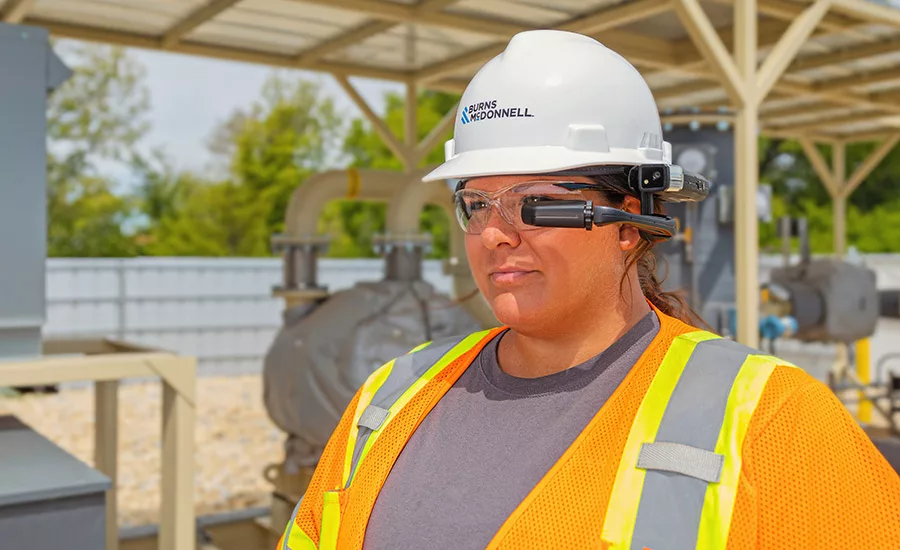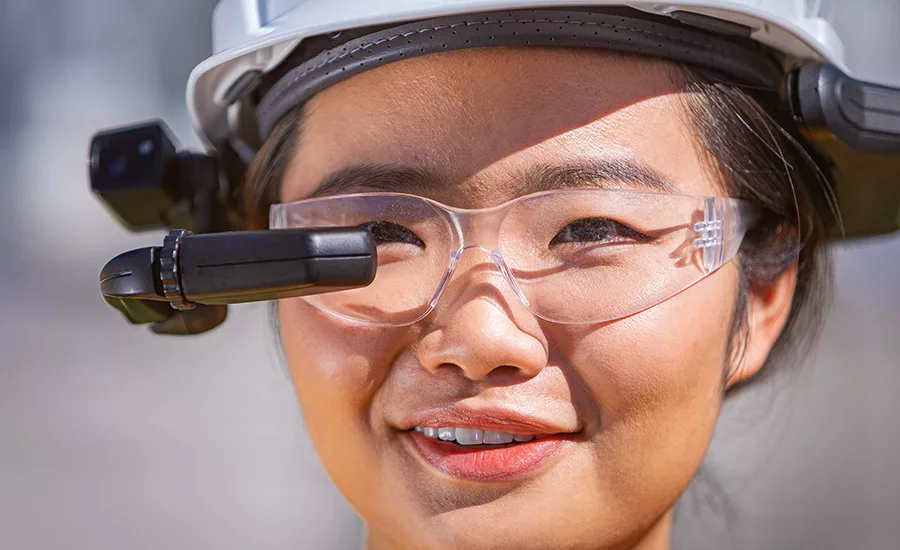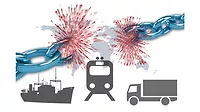Coping with COVID-19
COVID-19 review: Shorter supply chains and reliance on 3D tools for remote walk-throughs
While supply chain problems were plentiful, this A&E firm was able to keep food industry projects going with high-tech devices

RealWear technology can integrate into the work site, and has been used within the food and consumer products industry for years. Propelled by the pandemic, interest in and utilization of these devices increased, allowing on-site project teams to complete work remotely, including troubleshooting, maintenance, facility documenting and scoping of projects. All photos courtesy of Burns & McDonnell

The Matterport software platform uses artificial intelligence to create 3D models with high resolution and depth data--and enables virtual design collaboration when architects and engineers are distanced apart.

Engineers and architects use RealWear technology on location to document and scope projects.

3D is not necessarily new to the industry, but Matterport has made the process quicker and more user-friendly. Instead of taking thousands of photos and having to conduct manual measurements, this 3D model gives the perspective of virtually being in the space.

RealWear technology delivers the option to digitize processes that the workforce traditionally has done on pen and paper, again providing the benefit of being hands-free.
Recent trends caused mostly by the COVID-19 pandemic have put the squeeze on food processors and the supply chain to get food where it needs to go. Now as some states and cities are “opening up,” restaurants and other food service establishments are beginning to see their business increasing, which will mean a gradual shift in the supply chain—something that most processors and logistics providers will be able to handle, compared to a year ago when supply chains broke everywhere.
In this article, we look first at some of the supply chain issues that are still in flux as our industry adapts to ongoing shifts. A little later we look at two technologies (shown in the photos above) that have made it easier for architectural and engineering (A&E) firms to work remotely with their food and beverage customers, keeping the wheels of progress turning throughout the pandemic.
Supply chain woes
 |
| Jeremy Klysen, Burns & McDonnell |
Jeremy Klysen, cold storage and food distribution facilities leader at Burns & McDonnell explains the scenario that caught the industry off guard. “With the at-home food supply demand growing rapidly in response to the ongoing pandemic, grocery stores and other points within the food supply were facing difficulties under the strain.”
Food suppliers have the capacity to prepare for seasonal demands, such as candy at Halloween or turkeys at Thanksgiving, but the pandemic had spurred skyrocketing consumer grocery purchases, leaving stores scrambling to pick up the slack, says Klysen. Farmers were producing the same quantity of food; it’s those who were purchasing the supply whose habits were changing. With more people eating at home in reaction to restaurant shutdowns and perceived concerns over contaminated meals, grocery stores were seeing higher demand, and restaurants are seeing significantly fewer customers.
But according to Klysen, supply chain issues are not the only problem facing the food industry today. “In recent years, a rising trend in food has been consumers switching to fresh foods, with both health and taste considerations in mind.”
“As COVID-19 spread across the globe, consumers began to switch to bulk and frozen purchases to limit trips to the grocery store,” says Klysen. Frozen foods keep longer and often come in bigger packages for consumers to stock up on for a longer food supply at home. Food manufacturers are facing the burden of finding adequate third-party vendors to effectively manage inventory to supply the stress-induced food purchases and keep up with demand.
Throw in another variable in the retail sector that has had an ongoing effect on the food supply chain. “Grocery pickup and delivery service also has grown with the ongoing pandemic,” says Klysen. With store supply struggling to keep up with the demand, many consumers were seeing substitutes on orders or facing shortages of products normally readily available. Stores are losing market share when they have fewer products available, especially if other grocers across town have the desired products in stock.
“The food supply chain will need to find an economical way to meet increased sales while also balancing the fact that consumer food demand will eventually lessen,” says Klysen.
In fact, I would have to agree with Klysen as my last Giant order was fulfilled with no missing or substituted products—the first time since the pandemic began—a sign that the supply chain has caught up as restaurants and food service facilities begin to operate at expanded capacity, though still not full.
Push for solutions
Although COVID-19 won’t disappear overnight, Klysen sees permanent changes ahead for processors, and many of these changes have already been implemented. “While the food supply is unlikely to be contaminated from a crowded facility, the health of workers keeping the food plant running must be a top priority.”
Implementing enhanced airside solutions (such as laminar airflow with adequate outside air) and planning for increased distance between plant employees decreases the chances of workers getting sick from the coronavirus or becoming affected by another virus or disease that could halt production and endanger lives. Additionally, work breaks will most likely have to be staggered in the future to limit worker interaction for disease prevention, says Klysen.
“With much of the country’s food supply dependent on the ability of plant employees to continue working to process meat and other packaged food, the push toward automation is inevitable,” says Klysen. Manufacturers will most likely trend toward developing and implementing machinery to accomplish the same tasks that are normally completed by plant workers to prevent a food disruption from happening with a future pandemic or other life-altering event.
The food industry is likely to undergo major changes in the coming months and years in reaction to the COVID-19 crisis, says Klysen. Food manufacturers will have to determine the right food storage solution for the most cost-effective operation to keep up with consumer demand. The supply chain will likely be shortened, with food manufacturers attempting to limit disruption to food supply with more storage of products on-site, more manufacturer automation, and increased production of frozen and bulk types of food.
Technological aids keep architects and engineers working with processors
 |
 |
| (left) Zachary Wassenberg, PE and (right) Teddy Menke, Transmission & Distribution Group, Burns & McDonnell | |
Though we’ve briefly discussed in the past technologies that let architects provide virtual walk-throughs of new and expanded plants for their food processor clients, during COVID-19 these technologies proved themselves indispensable. Zachary Wassenberg, PE, product engineer, and Teddy Menke, product engineer, both in the Transmission & Distribution Group at Burns & McDonnell, describe these technologies below.
RealWear, an assisted reality wearables company, whose technology can integrate into the work site, has been used within the food and consumer products industry for years. Propelled by the pandemic, interest in and utilization of these devices increased, allowing on-site project teams to complete work remotely, including troubleshooting, maintenance, facility documenting and scoping of projects.
In fact, Burns & McDonnell recently integrated the technology into work streams for those purposes within the meat producing facilities. Though this technology kept critical infrastructure projects moving last year, the bigger trend is how it reduces operational costs and helps fill significant knowledge gaps, leveraging video recording capabilities to document the work of seasoned professionals.
In a food and consumer products area, workers need to be hands-free to operate equipment, and wearables can provide that. Additionally, RealWear technology delivers the option to digitize processes that the workforce traditionally has done on pen and paper, again providing the benefit of being hands-free.
Another trend taking off in multiple industries, including food and consumer products, is Matterport, a software platform that uses artificial intelligence to create 3D models using high-resolution images and depth data. Essentially, it enables a virtual design collaboration of the physical world. The company also creates some of its own hardware to capture data and create models.
3D is not necessarily new to the industry, but Matterport has made the process quicker and more user-friendly. Instead of taking thousands of photos and having to conduct manual measurements, this 3D model gives the perspective of virtually being in the space. Without requiring special software, employees can measure things like equipment, clearances and cable lengths using the depth data behind an image, within Matterport’s platform, which anyone can access with the right permission.
Delivering an optimal virtual experience, Matterport leads a client, contractor or bidder virtually though a space, just as if they were on-site. Additional documentation, including manuals, tags with multimedia videos and photos, also can be added into the space to build context. Users can annotate within the space as well to communicate progress points throughout a project. The 3D data then also can be exported for use within CAD software, establishing design based off of that 3D model.
The biggest benefit of this solution is “seeing” a space without physically being in it, which has allowed work to continue during the pandemic. Production lines had to remain operational, and this photo-realistic digital twin kept lines moving, capturing real-time data for project members and management as well as the client. This technology is simpler to deploy and requires less effort post-processing (because of AI), creating 3D renderings that easily can be interpreted and understood by those without an engineering background who also rely on them.
For more information, visit Burns & McDonnell.
Looking for a reprint of this article?
From high-res PDFs to custom plaques, order your copy today!








